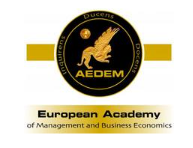Enhancing lecture comprehension in English medium of instruction: a case study of an international business management programme in Belgium
DOI:
https://doi.org/10.35564/jmbe.2024.0009Keywords:
English medium of instruction, EMI, Higher education, second language, listening, business educationAbstract
The growing global trend of adopting English as a Medium of Instruction (EMI) in higher education, particularly in non-English-speaking countries, presents a unique set of challenges. This study focuses on a group of students in Belgium navigating EMI within the context of a bachelor’s degree programme in International Business Management. It delves into the strategies employed by both lecturers and students to enhance learning outcomes while listening to EMI lectures.
Through classroom observations and focus groups with EMI students, this research uncovers valuable insights into effective teaching and strategies that can be instrumental in ensuring EMI does not hinder the achievement of educational objectives. The study's findings contribute by putting forward a comprehensive repertoire of didactic strategies and resources, offering valuable guidance to lecturers, students, and curriculum developers involved in the EMI landscape of higher education, with a particular emphasis on improving students' comprehension of lecture content.
Downloads
References
Aguilar, M., & Rodríguez, R. (2011). Lecturer and student perceptions on CLIL at a Spanish university. International Journal of Bilingual Education and Bilingualism, 15(2), 183-197. https://doi.org/10.1080/13670050.2011.615906
Airey, J. (2011). The relationship between Teaching Language and Student Learning in Swedish University Physics. In B. Preisler, A. Fabricius & I. Klitgård (Eds.), Language and Learning in the International University: From English Uniformity to Diversity and Hybridity (pp. 3-18). Bristol: Multilingual Matters.
https://doi.org/10.21832/9781847694157-004
Airey, J., Lauridsen, K. M., Räsänen, A., Salö, L., & Schwach, V. (2017). The expansion of English-medium instruction in the Nordic countries: Can top-down university language policies encourage bottom-up disciplinary literacy goals? Higher Education, 73(4), 561-576. https://doi.org/10.1007/s10734-015-9950-2
Airey, J., & Linder, C. (2006). Language and the experience of learning university physics in Sweden. European Journal of Physics, 27(3), 553-560. https://doi.org/10.1088/0143-0807/27/3/009
Airey, J. & Linder, C. (2008). Bilingual Scientific Literacy? The Use of English in Swedish University Science Courses. Nordic Journal of English Studies 7(3), 145-161. https://doi.org/10.35360/njes.105
Arkın, E. & Osam, N. (2015). English-medium higher education: A case study in a Turkish university context. In S. Dimova, A. Hultgren & C. Jensen (Eds.), English-Medium Instruction in European Higher Education Volume 3 (pp. 177-200). De Gruyter Mouton. https://doi.org/10.1515/9781614515272-010
Björkman, B. (2013). English as an Academic Lingua Franca: An Investigation of Form and Communicative Effectiveness. Walter de Gruyter. https://doi.org/10.1515/9783110279542
Brown, H. D. (2001). Teaching by Principles: An Interactive Approach to Language Pedagogy (2nd ed.). Longman.
Carroll, J. (2015). Tools for Teaching in an Educationally Mobile World (1st ed). Routledge. https://doi.org/10.4324/9781315765433
Chuang, Y. (2015). An EMI Pedagogy That Facilitates Students' Learning. English Language Teaching, 8(12), 63-73. https://doi.org/10.5539/elt.v8n12p63
Costa, F., &. Coleman, J. A. (2012). A survey of English-medium instruction in Italian higher education. International Journal of Bilingual Education and Bilingualism 16(1), 3-19. https://doi.org/10.1080/13670050.2012.676621
Curle, S., Ratkaine Jablonkai, R., Mittelmeier, J., Sahan, K., Veitch, A., & Galloway, N. (Eds.) (2020). English in higher education - English medium. Part 1: Literature review. English in higher education - English medium British Council. Retrieved from https://www.teachingenglish.org.uk/sites/teacheng/files/L020_English_HE_lit_review_FINAL.pdf
Dafouz, E., & Smit, U. (2020). ROAD-MAPPING English Medium Education in the Internationalised University. Palgrave Macmillan. https://doi.org/10.1007/978-3-030-23463-8
Dearden, J. (2014). English as a medium of instruction - a growing global phenomenon. British Council. Retrieved from https://www.britishcouncil.org/sites/default/files/e484_emi_-_cover_option_3_final_web.pdf
Dearden, J. (2018). The Changing Roles of EMI Academics and English Language Specialists. In Kırkgöz, Y. & Dikilitaş, K. (Eds.), Key Issues in English for Specific Purposes in Higher Education. Springer International Publishing. https://doi.org/10.1007/978-3-319-70214-8
De Chazal, E. (2014). English for Academic Purposes. Oxford University Press.
Doiz, A., Costa, F., Lasagabaster, D., and Mariotti, C. (2020). Linguistic demands and language assistance in EMI courses: What is the stance of Italian and Spanish undergraduates? Lingue e Linguaggio. 33. 69-85. http://doi.org/10.1285/i22390359v33p69
Doiz, A., & Lasagabaster, D. (2018). Teachers' and Students' Second Language Motivational Self System in English-Medium Instruction: A Qualitative Approach. TESOL Quarterly, 52(3), 657-679. https://doi.org/10.1002/tesq.452
Ellis, D. (2015). Using Padlet to increase student engagement in lectures. In Jefferies, A. & Cubric, M. (Eds.), ECEL2015-14th European Conference on e-Learning: ECEl2015, 195-199. Academic Conferences and publishing limited.
Evans, S., & Morrison, B. (2011). The student experience of English-medium higher education in Hong Kong. Language and Education, 25(2), 147-162. https://doi.org/10.1080/09500782.2011.553287
Flowerdew, J. (Ed.). (1995). Academic Listening: Research Perspectives (Cambridge Applied Linguistics). Cambridge University Press. https://doi.org/10.1017/CBO9781139524612
Flowerdew, J., Li, D., & Miller, L. (1998). Attitudes Towards English and Cantonese Among Hong Kong Chinese University Lecturers. TESOL Quarterly 32(2), 10-40. https://doi.org/10.2307/3587582
Francis, W. S., & Gutiérrez, M. (2012). Bilingual recognition memory: Stronger performance but weaker levels-of-processing effects in the less fluent language. Memory & Cognition, 40(3), 496-503. https://doi.org/10.3758/s13421-011-0163-3
Gollan, T. H., Montoya, R. I., Cera, C., & Sandoval, T. C. (2008). More use almost always means a smaller frequency effect: Aging, bilingualism, and the weaker links hypothesis. Journal of Memory and Language, 5(58), 78-814. https://doi.org/10.1016/j.jml.2007.07.001
Guarda, M. & Helm, F. (2017) 'I have discovered new teaching pathways': the link between language shift and teaching practice. International Journal of Bilingual Education and Bilingualism, 20(7), 897-913. https://doi.org/10.1080/13670050.2015.1125848
Ha, J. (2018). Using mobile-based Slido for effective management of a university English reading class. Multimedia-Assisted Language Learning, 21(4), 37-56.
Hahl, K., Järvinen, H., & Juuti, K. (2014). Accommodating to English-medium instruction in teacher education in Finland. International Journal of Applied Linguistics, 26(3), 291-310. https://doi.org/10.1111/ijal.12093
Hernandez-Nanclares, N. & Antonio Jimenez-Munoz, A. (2017) English as a medium of instruction: evidence for language and content targets in bilingual education in economics. International Journal of Bilingual Education and Bilingualism, 20(7), 883-896. https://doi.org/10.1080/13670050.2015.1125847
Howitt, D. (2010). Introduction to qualitative methods in psychology. Prentice Hall.
İpek, H. (2018) Perceptions of ELT students on their listening and note taking skills. International Online Journal of Education and Teaching (IOJET), 5(1), 206-217. http://iojet.org/index.php/IOJET/article/view/281/226
Jensen, C., & Thøgersen, J. (2011). Danish University lecturers' attitudes towards English as the medium of instruction. Ibérica 22, 13-34.
Kagwesage, A. M. (2013). Coping with English as Language of Instruction in Higher Education in Rwanda. International Journal of Higher Education 2(2), 1-12. https://doi.org/10.5430/ijhe.v2n2p1
Kim, A., Dae Son, Y., & Sohn, S.Y. (2009). Conjoint analysis of enhanced English Medium Instruction for college students. Expert Systems with Applications 36, 10197-10203. https://doi.org/10.1016/j.eswa.2009.01.080
Kling, J. (2015). "You try with a little humor and you just get on with it": Danish lecturers' reflections on English-medium instruction. In S. Dimova, A. Hultgren & C. Jensen (Ed.), English-Medium Instruction in European Higher Education Volume 3, 201-222. De Gruyter Mouton. https://doi.org/10.1515/9781614515272-011
Kremer, M. (2021). When the teaching language is not the mother tongue: support of students in higher education. [Doctoral dissertation, Ghent University]. http://hdl.handle.net/1854/LU-8729912
Liang, X., & Smith, S.W. (2012). Teaching Language and Content: Instructor Strategies in a Bilingual Science Class at a Chinese University. International Journal of Higher Education 1(2), 92-102. https://doi.org/10.5430/ijhe.v1n2p92
Lynch, T. (2011). Academic listening in the 21st century: Reviewing a decade of research. Journal of English for Academic Purposes, 10(2), 79-88. https://doi.org/10.1016/j.jeap.2011.03.001
Macaro, E. (2018). English Medium Instruction: Content and Language in Policy and Practice. Oxford University Press.
Macaro, E., Akincioglu, M., & Han, S. (2020). English medium instruction in higher education: Teacher perspectives on professional development and certification. International Journal of Applied Linguistics, 30(1), 144-157. https://doi.org/10.1111/ijal.12272
Macaro, E., Curle, S., Pun, J., An, J., & Dearden, J. (2018). A systematic review of English medium instruction in higher education. Language Teaching, 51(1), 36-76. https://doi.org/10.1017/S0261444817000350
Marsh, D. (2000) An introduction to CLIL for parents and young people. In Marsh, D.; Langé, G. (Eds.) Using languages to learn and learning to use languages. (pp. 1-16). University of Jyväskylä.
Murphey, T. (1997). Content-based instruction in an EFL setting: Issues and strategies. In Brinton, M.D. & Marguerite, A. S. (Eds.), The Content-Based Classroom - Perspectives on Integrating language and content (pp. 117-131). Longman.
O'Dowd, R. (2018). The training and accreditation of teachers for English medium instruction: an overview of practice in European universities. International Journal of Bilingual Education and Bilingualism, 21(5), 553-563. https://doi.org/10.1080/13670050.2018.1491945
Paxton, M.I.J. (2008) 'It's easy to learn when you using your home language but with English you need to start learning language before you get to the concept': bilingual concept development in an English medium university in South Africa. Journal of Multilingual and Multicultural Development, 30(4), 345-359. https://doi.org/10.1080/01434630902780731
Prague Communiqué (2001). Towards the European Higher Education Area: Communiqué of the meeting of European Ministers in charge of Higher Education. Retrieved from http://www.encore-edu.org/ENCoRE-documents/prague.pdf
Pun, J. K., & Thomas, N. (2020). English medium instruction: teachers' challenges and coping strategies. ELT Journal, 74(3), 247-257. https://doi.org/10.1093/elt/ccaa024
Rochecouste, J., Oliver, R., Mulligan, D., & Davies, M. (2010). Addressing the Ongoing English Language Growth of International Students. Australian Learning and Teaching Council (Report).
Rost, M. (2011). Teaching and Researching: Listening (2nd ed.). Pearson Education Limited.
Schmidt-Unterberger, B. (2018) The English-medium paradigm: a conceptualisation of English-medium teaching in higher education. International Journal of Bilingual Education and Bilingualism, 21(5), 527-539. https://doi.org/10.1080/13670050.2018.1491949
Soruç, A., Dinler, A., & Griffiths, C. (2018). Listening Comprehension Strategies of EMI Students in Turkey. In Kırkgöz, Y. & Dikilitaş, K. (Eds), Key Issues in English for Specific Purposes in Higher Education (pp. 265-287). Springer International Publishing.
https://doi.org/10.1007/978-3-319-70214-8_15
Valcke, M. (2010). Onderwijskunde als ontwerpwetenschap: Een inleiding voor ontwikkelaars van instructie en voor toekomstige leerkrachten. Academia Press.
Van Splunder, F. (2010). English as a Medium of Instruction in Flemish Higher Education-Language and Identity Management in a Dutch-Speaking Context (Doctoral dissertation), Lancaster University.
Weber, A., & Cutler, A. (2004). Lexical competition in non-native spoken-word recognition. Journal of Memory and Language, 50, 1-25. https://doi.org/10.1016/S0749-596X(03)00105-0
Wilkinson, R. (2005). The impact of language on teaching content: Views from the content teacher (Doctoral dissertation), Technische Universiteit Delft.
Wilkinson, R. (2013). English-medium instruction at a Dutch university: Challenges and pitfalls. In Doiz, A., & Lasagabaster, D. D (Eds.), English-medium instruction at universities: Global challenges (pp. 1-24). Buffalo. https://doi.org/10.21832/9781847698162-005
You, X., & You, X. (2013). American content teachers' literacy brokerage in multilingual university classrooms. Journal of Second Language Writing, 22, 260-276. https://doi.org/10.1016/j.jslw.2013.02.004

Downloads
Published
How to Cite
Issue
Section
License
Copyright (c) 2024 Journal of Management and Business Education

This work is licensed under a Creative Commons Attribution-NonCommercial-ShareAlike 4.0 International License.
License terms at: https://creativecommons.org/licenses/by-nc/4.0/legalcode



